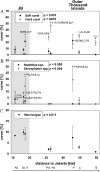Abundance and physiology of dominant soft corals linked to water quality in Jakarta Bay, Indonesia
- PMID: 27904802
- PMCID: PMC5127238
- DOI: 10.7717/peerj.2625
Abundance and physiology of dominant soft corals linked to water quality in Jakarta Bay, Indonesia
Abstract
Declining water quality is one of the main reasons of coral reef degradation in the Thousand Islands off the megacity Jakarta, Indonesia. Shifts in benthic community composition to higher soft coral abundances have been reported for many degraded reefs throughout the Indo-Pacific. However, it is not clear to what extent soft coral abundance and physiology are influenced by water quality. In this study, live benthic cover and water quality (i.e. dissolved inorganic nutrients (DIN), turbidity (NTU), and sedimentation) were assessed at three sites (< 20 km north of Jakarta) in Jakarta Bay (JB) and five sites along the outer Thousand Islands (20-60 km north of Jakarta). This was supplemented by measurements of photosynthetic yield and, for the first time, respiratory electron transport system (ETS) activity of two dominant soft coral genera, Sarcophyton spp. and Nephthea spp. Findings revealed highly eutrophic water conditions in JB compared to the outer Thousand Islands, with 44% higher DIN load (7.65 μM/L), 67% higher NTU (1.49 NTU) and 47% higher sedimentation rate (30.4 g m-2 d-1). Soft corals were the dominant type of coral cover within the bay (2.4% hard and 12.8% soft coral cover) compared to the outer Thousand Islands (28.3% hard and 6.9% soft coral cover). Soft coral abundances, photosynthetic yield, and ETS activity were highly correlated with key water quality parameters, particularly DIN and sedimentation rates. The findings suggest water quality controls the relative abundance and physiology of dominant soft corals in JB and may thus contribute to phase shifts from hard to soft coral dominance, highlighting the need to better manage water quality in order to prevent or reverse phase shifts.
Keywords: Coral reefs; Electron transport system (ETS) activity; Eutrophication; Megacity; Nephthea spp.; Phase shifts; Photosynthetic yield; Pollution; Sarcophyton spp..
Conflict of interest statement
The authors declare that they have no competing interests.
Figures





Similar articles
-
Local and Regional Impacts of Pollution on Coral Reefs along the Thousand Islands North of the Megacity Jakarta, Indonesia.PLoS One. 2015 Sep 17;10(9):e0138271. doi: 10.1371/journal.pone.0138271. eCollection 2015. PLoS One. 2015. PMID: 26378910 Free PMC article.
-
Variation in the composition of corals, fishes, sponges, echinoderms, ascidians, molluscs, foraminifera and macroalgae across a pronounced in-to-offshore environmental gradient in the Jakarta Bay-Thousand Islands coral reef complex.Mar Pollut Bull. 2016 Sep 30;110(2):701-17. doi: 10.1016/j.marpolbul.2016.04.042. Epub 2016 May 11. Mar Pollut Bull. 2016. PMID: 27179997
-
Long-term effects of competition and environmental drivers on the growth of the endangered coral Mussismilia braziliensis (Verril, 1867).PeerJ. 2018 Aug 10;6:e5419. doi: 10.7717/peerj.5419. eCollection 2018. PeerJ. 2018. PMID: 30128199 Free PMC article.
-
Urban coral reefs: Degradation and resilience of hard coral assemblages in coastal cities of East and Southeast Asia.Mar Pollut Bull. 2018 Oct;135:654-681. doi: 10.1016/j.marpolbul.2018.07.041. Epub 2018 Aug 1. Mar Pollut Bull. 2018. PMID: 30301085 Review.
-
Environmental impacts of dredging and other sediment disturbances on corals: a review.Mar Pollut Bull. 2012 Sep;64(9):1737-65. doi: 10.1016/j.marpolbul.2012.05.008. Epub 2012 Jun 7. Mar Pollut Bull. 2012. PMID: 22682583 Review.
Cited by
-
Effective asexual reproduction of a widespread soft coral: comparative assessment of four different fragmentation methods.PeerJ. 2022 Jan 19;10:e12589. doi: 10.7717/peerj.12589. eCollection 2022. PeerJ. 2022. PMID: 35111389 Free PMC article.
-
Short-term ocean acidification decreases pulsation and growth of the widespread soft coral Xenia umbellata.PLoS One. 2023 Nov 15;18(11):e0294470. doi: 10.1371/journal.pone.0294470. eCollection 2023. PLoS One. 2023. PMID: 37967066 Free PMC article.
-
Dissolved Nitrogen Acquisition in the Symbioses of Soft and Hard Corals With Symbiodiniaceae: A Key to Understanding Their Different Nutritional Strategies?Front Microbiol. 2021 Jun 4;12:657759. doi: 10.3389/fmicb.2021.657759. eCollection 2021. Front Microbiol. 2021. PMID: 34149646 Free PMC article.
-
Photosynthesis and respiration of the soft coral Xenia umbellata respond to warming but not to organic carbon eutrophication.PeerJ. 2021 Jul 27;9:e11663. doi: 10.7717/peerj.11663. eCollection 2021. PeerJ. 2021. PMID: 34395065 Free PMC article.
-
Species-Specific Response of Corals to Imbalanced Ratios of Inorganic Nutrients.Int J Mol Sci. 2023 Feb 4;24(4):3119. doi: 10.3390/ijms24043119. Int J Mol Sci. 2023. PMID: 36834529 Free PMC article.
References
-
- Abrar M, Zamani NP, Wayan Nurjaya DI. Coral recruitment, survival and growth of coral species at Pari Island, Thousand Islands, Jakarta: a case study of coral resilience. Journal of Indonesian Coral Reefs. 2011;1(1):7–14.
-
- Anderson MJ. Permutation tests for univariate or multivariate analysis of variance and regression. Canadian Journal of Fisheries and Aquatic Sciences. 2001;58(3):626–639. doi: 10.1139/f01-004. - DOI
-
- Anthony KRN, Hoegh-Guldberg O. Variation in coral photosynthesis, respiration and growth characteristics in contrasting light microhabitats: an analogue to plants in forest gaps and understoreys? Functional Ecology. 2003;17(2):246–259. doi: 10.1046/j.1365-2435.2003.00731.x. - DOI
-
- Arifin Z. Local Millenium Ecosystem Assessment: Condition and Trend of the Greater Jakarta Bay Ecosystem. Jakarta: The Ministry of Environment; 2004.
-
- Badan Pusat Statistik (BPS) Jumlah penduduk menurut jenis kelamin dan Rumahtangga Provinsi DKI Jakarta sampai level kelurahan (Hasil Sensus Penduduk 2000 dan 2010) (catatan: dapat menampilkan penduduk per kelompok umur, piramida penduduk dan dapat diurutkan–lihat petunjuk penggunaan) 2012. http://jakarta.bps.go.id/ [31 May 2012]. http://jakarta.bps.go.id/
LinkOut - more resources
Full Text Sources
Other Literature Sources
Research Materials
Miscellaneous

